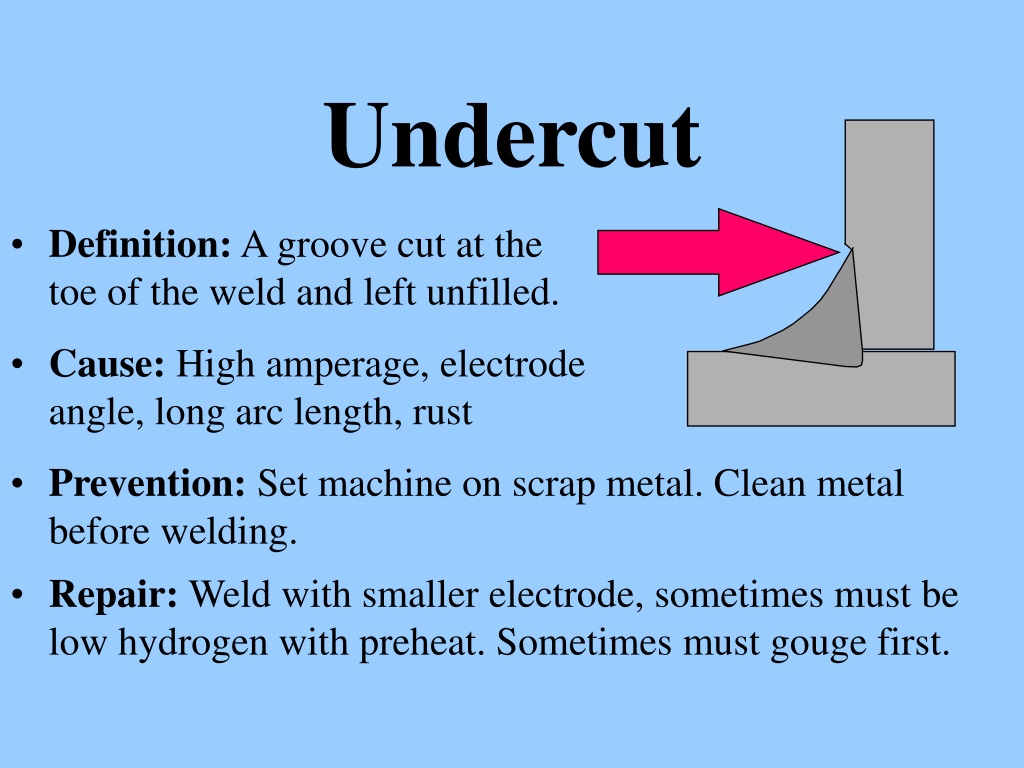Professional Techniques for Preventing Weld Undercut Effectively
Professional Techniques for Preventing Weld Undercut Effectively
Blog Article
Recognizing the Causes and Solutions for Undercut Welding in Steel Fabrication Processes
In the world of steel manufacture procedures, the event of undercut welding poses a considerable difficulty that requires a detailed understanding of its reasons and feasible options. The complex interaction of different aspects during welding operations can result in this undesirable phenomenon, impacting the architectural honesty and general high quality of the welded joints - Preventing weld undercut. By dissecting the source of undercut welding and discovering reliable restorative steps, fabricators can elevate the criterion of their craftsmanship and make sure the production of flawless steel components
Typical Root Causes Of Undercut Welding
Frequently forgotten in metal construction, undercut welding occurs because of different elements that demand thorough interest and know-how to be efficiently mitigated. One usual root cause of undercut welding is excessive warmth input. When the warm input is too high, it can bring about the melting and subsequent disintegration of the base material along the sides of the weld joint, producing a groove or undercut. Additionally, improper welding strategies, such as utilizing the incorrect welding angle or travel rate, can likewise add to undercut development. Insufficient securing gas protection is another crucial aspect that can cause damaging. Insufficient gas coverage falls short to safeguard the weld swimming pool appropriately, bring about oxidation and undercut issues. The selection of welding parameters, such as voltage, existing, and wire feed speed, plays a significant role in the incident of undercut welding. Understanding these common reasons is vital for implementing safety nets and making sure top quality welds in metal construction procedures.
Impact of Incorrect Welding Parameters
Incorrect welding parameters can significantly endanger the honesty and top quality of bonded joints in metal fabrication procedures. The impact of inaccurate welding specifications materializes in various ways, leading to architectural weak points and flaws in the bonded elements. One vital element affected by improper welding criteria is the infiltration depth of the weld. Insufficient warmth input as a result of low welding currents or exceedingly high travel rates can lead to insufficient fusion in between the base metals, bring about insufficient joint penetration and weakened bonds. Alternatively, extreme heat input brought on by high welding currents or slow-moving travel rates can cause burn-through and extreme reinforcement, developing a breakable and unstable weld framework. Furthermore, incorrect criteria such as incorrect voltage setups or inaccurate electrode angles can add to irregular weld bead accounts, absence of blend, and increased chances of issues like undercutting. Therefore, meticulous interest to welding criteria is extremely important to guarantee the production of high-quality welds with the wanted mechanical homes and architectural integrity.
Impact of Improper Lantern Angle
Inappropriate lantern angle in welding operations can considerably impact the quality and honesty of the last weld joints in steel construction processes. Damaging is an usual welding flaw where a groove develops along the weld toe, compromising the joint and compromising its architectural stability.
A torch angle that is also steep can result in inadequate infiltration, insufficient fusion, and boosted spatter. On the other hand, a torch angle that is as well shallow can lead to extreme infiltration, burn-through, and distortion of the base material. Preventing weld undercut. Proper lantern angle is necessary for making certain consistent weld high quality, strength, and appearance
To stop undercutting and other problems created by inappropriate lantern angles, welders have to be educated to maintain the right torch angle throughout the welding procedure. Routine tracking and modification of lantern angles during welding can aid accomplish sound welds with marginal issues.
Role of Inadequate Welding Techniques

An additional aspect of inadequate welding strategies is incorrect weld preparation. Insufficient cleansing of the base steels, wrong joint layout, or insufficient side prep work can all add to undercut welding. Poor securing gas insurance coverage or utilizing the wrong kind of gas can result in incomplete combination and the formation of undercut defects.
To deal with the duty of poor welding strategies in steel fabrication procedures, it is essential to offer thorough training for welders. Appropriate education on welding specifications, joint web link preparation, and securing gas choice can aid avoid undercut welding and guarantee high-quality welds in steel manufacture jobs.
Reliable Solutions for Undercut Welding
Resolving undercut welding in metal fabrication needs carrying out efficient options to improve weld quality and architectural honesty. One of the primary solutions to fight undercut is to readjust welding parameters such as voltage, current, and travel rate to ensure proper warmth input and fusion. By fine-tuning these settings, welders can stop too much melting of the base steel and filler material, decreasing the likelihood of undercut formation.
In addition, proper joint preparation is important in preventing undercut. Ensuring tidy base steel surface areas complimentary of impurities and utilizing the appropriate bevel angle can help advertise much better weld infiltration and lower the threat of undercut - Preventing weld undercut. Utilizing suitable welding strategies, such as oscillating the torch or weaving, can likewise assist in distributing warm evenly and filling the weld joint properly, reducing the opportunity of undercut flaws
Moreover, choosing the proper welding consumables, consisting of electrodes and filler metals, is essential in mitigating undercut. Utilizing products with appropriate chemical structures and mechanical homes can add to achieving sound welds with marginal undercut. Regular evaluation and quality control measures ought to also be applied to find and address undercut concerns without delay, making sure the overall honesty of produced metal parts.

Verdict
Finally, recognizing the causes and options for undercut welding in metal construction processes is vital for achieving top notch welds. By attending to usual reasons such as wrong welding specifications, improper lantern angle, and poor welding techniques, welders can prevent damaging and make certain strong, resilient welds. It is essential to take note of these variables and carry out reliable options to improve the total welding procedure and final product quality.

Report this page